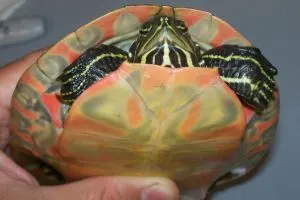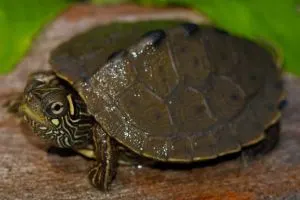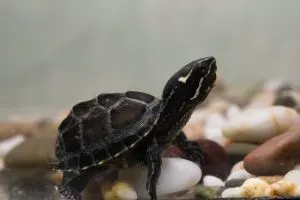Turtle life spans range quite broadly anywhere from 15 – 30+ year. Turtle & tortoise species are among the longest-living animals on planet earth.
Turtles live longer than most pets we have around the house. Many species normally kept as pets can easily live well into their 30s.
A turtle’s lifespan needs to be taken into consideration when acquiring a turtle. Also, if you can no longer care for your pet turtle it’s best to find a good home for your pet turtle when you can no longer care for it.
You can check our adoption page for people giving up and wanting turtles. Check the comments at the bottom.
Turtles should never be released into the wild. The turtle will likely not survive, and if it does could wreak havoc on the local ecosystem.
A captive turtle’s lifespan is also determined by factors such as its enclosure, diet, and care.
Table of Contents
How long do turtles live?
Lifespans of Popular Turtle Species Commonly Kept as Pets
1. Cooters

- (Average Lifespan in captivity 20 years)
Cooters (Pseudemys) are among some of the largest freshwater turtles kept as pets and are capable of reaching over a foot in length.
There are eight subspecies of cooters, namely – Alabama Redbelly Turtle (Pseudemys alabamensis), Eastern River Cooter (Pseudemys concinna), Western River Cooter (Pseudemys gorzugi), Florida Redbelly Turtle (Pseudemys nelsoni), Peninsula Cooter (Pseudemys peninsularis), Eastern Redbelly Turtle (Pseudemys rubriventris), Suwannee River Cooter (Pseudemys suwanniensis), and Texas River Cooter (Pseudemys texana).
On average cooters have a lifespan of 20 years in captivity.
The river cooter (Pseudemys concinna), is probably the most popular cooter in the pet trade. River cooters also known as Eastern river cooters, have an average lifespan of 20 years and a maximum lifespan of 44 years in captivity. In the wild, river cooters have a lifespan of 40 years.
The Florida Redbelly Turtle (Pseudemys nelsoni), also known as the Florida red-bellied cooter, has a captive lifespan of about 33 years (high).
The Northern red-bellied cooter (Pseudemys rubriventris), also known as the eastern redbelly cooter, has a lifespan that ranges from 40 to 55 years in the wild. In captivity, their lifespan is unknown.
The peninsula cooter (Pseudemys peninsularis) has a longevity of 30 years both in captivity and in the wild.
2. Map Turtle

- Average Lifespan in captivity 5.5 years
Map turtles belong to the genus Graptemys. Also known as sawback turtles, there are 15 map turtle species available. Their small size and affable nature make map turtles one of the turtles most commonly kept as pets.
Popular map turtle species include Northern map turtle, false map turtle, Mississippi map turtle, Barbour’s map turtle, Cagle’s map turtle, Black-knobbed map turtle, Ringed map turtle, Texas Map Turtle, and Alabama map turtle.
The northern map turtle (Graptemys geographica), also known as common map turtles, has an average lifespan of 5.5 years in captivity but can live to be more than 20 years.
The oldest known captive northern map turtle lived for 18 years in captivity. In the wild, the Graptemys geographica can live to over 20 years.
The false map turtle species (G. pseudogeographica) includes the Mississippi map turtle (G. p. kohnii) and the nominotypical subspecies (G. p. pseudogeographica). The oldest false map turtle on record lived for 35 years and 5 months at the Columbus Zoo.
The Barbour’s map turtle (Graptemys barbouri). The oldest specimen of the species recorded was in captivity for 31 years 8 months and 9 days before passing away.
The Cagle’s map turtle (Graptemys caglei) has a maximum longevity of 14 years and 6 months in captivity.
The black-knobbed map turtle (Graptemys nigrinoda) specimens have lived to be 20.3 years in captivity.
The ringed map turtle (Graptemys oculifera) has an average lifespan of 12 years in captivity. In the wild, males live to be 23.5 to 25.5 years, and females live to be 31 to 37 years.
The Alabama map turtle (Graptemys pulchra) has a lifespan of about 10 years with the oldest captive recorded attained an age of 15.7 years.
3 – 4. Musk & Mud Turtle

- Average Lifespan in captivity 20 years
Mud turtles include turtles that belong to the genus Kinosternon. Among turtles, mud turtles have an average lifespan of 20 years with the species living to 50 years with proper care.
There are about 19 mud turtle species. popular mud turtles include the eastern mud turtle, the Mississippi mud turtle, striped mud turtle, and yellow mud turtle.
The eastern mud turtles (K. subrubrum) have an average lifespan of 20 years in captivity but can live to 50 years. In the wild, the Kinosternon subrubrum has a maximum longevity of 40 years. The Mississippi mud turtle (K. s. hippocrepis) is a subspecies of the eastern mud turtle.
The striped mud turtles (K. baurii) can live to be over 50 years. The oldest striped mud turtle on record lived for 49 years before dying in a fire. This specimen was captured from the wild and was healthy at the time of her untimely death.
The yellow mud turtle (K. flavescens) have an average lifespan of 10 years in captivity and about 15 years in the wild.

Musk turtles are closely related to mud turtles. In fact, both turtles belong to the same family – Kinosternidae. Musk turtles belong to the genus Sternotherus.
The razor-backed musk turtle (S. carinatus) is one of the more popular musk turtles kept as pets. While there is little information on their lifespan estimates ranges from 20 years to 50 years. According to (Franklin, 2015), the longest lifespan on record is 29 years in captivity. Their lifespan in the wild is unknown.
The flattened Musk Turtle (S. depressus) specimens have lived to over 20 years in captivity. Little is known about the lifespan of the critically endangered flattened musk turtle species in the wild.
The stinkpot turtle (S. odoratus), also known as the common musk turtle, has a maximum lifespan of 54.8 years in captivity.
The loggerhead turtle (S. odoratus) has a lifespan of about 20 years with the oldest captive recorded attained an age of 23 years and 11 months. In the wild, the oldest record is 21 years. However, biologists believe loggerhead turtles live longer.
5. Painted Turtle

- Average Lifespan in captivity 35-40 years
The painted turtle (Chrysemys picta) is common in North America. Belonging to the genus Chrysemys, the painted turtle is one of the turtles commonly kept as pets.
There are four subspecies based on geographical locations. These include the eastern painted turtle (C. p. picta), the midland painted turtle (C. p. marginata), the southern painted turtle (C. p. dorsalis), and the western painted turtle (C. p. bellii).
Growth rings can be used to determine the age of painted turtles below the age of four. For adults, growth rings can be used to estimate their age.
According to studies, painted turtles can live to be over 55 years. The average lifespan of painted turtles in the wild and in captivity is 35 to 40.
6. Pond Slider

- Average Lifespan in captivity 20 years
Pond sliders (Trachemys scripta) include turtles such as the red-eared slider (T. s. elegans), the Yellow-bellied slider(T. s. scripta), and the Cumberland slider(T. s. troostii).
Although pond sliders are among the most popular turtles kept as pets, determining their maximum lifespan can be tough as owners tend to exaggerate the age of their pets.
Also, owners are known to release sliders into the wild. However, the data available suggests that captive sliders can live up to over 40 years. In the wild, sliders can live to 30 years.
7. Diamondback Terrapin

- Average Lifespan in captivity 10 years
Diamondback terrapin (Malaclemys terrapin) is another well-known and well-loved species of turtle.
Little is known of Malaclemys terrapin lifespan in the wild or in captivity. The oldest recorded diamondback terrapin was 14.1 years. Anecdotal reports suggest that diamondback terrapins can live to be over 40 years.
8. Wood Turtle

- Average Lifespan in captivity 30 years
The wood turtle, also known as the North American wood turtle belongs to the genus Glyptemys and bears the binomial name – Glyptemys insculpta.
The wood turtle is not to be confused with the painted wood turtle which belongs to the genus Rhinoclemmys and bears the binomial name – Rhinoclemmys pulcherrima.
Little is known about wild wood turtle lifespan. The maximum lifespan of wood turtles in captivity is 60 years.
9. Painted Wood Turtle

- Average Lifespan in captivity 20 years
The painted wood turtle is another popular North American turtle kept as pets. Painted wood turtles are also known as ornate wood turtles and belong to the genus Rhinoclemmys and bear the binomial name – Rhinoclemmys pulcherrima. Don’t confuse the painted wood turtle with the wood turtle.
There are four subspecies of the painted wood turtle – the Honduras wood turtle(R. p. incisa), the nominate subspecies (R. p. pulcherrima), Central American wood turtle (R. p. manni), and the Mexican wood turtle (R. p. rogerbarbouri).
The painted wood turtle has a lifespan of 20.4 years in captivity.
Best Practices For Attaining Long Lifespans
Proper Feeding
It’s important to properly feed your turtle if you want it to live a long and healthy life. Many turtles aren’t picky eaters and will accept whatever you offer them.
However, that doesn’t mean you should feed them whatever you get your hands on. Foods that might be healthy for you could prove to be unhealthy for your turtles.
For instance, many fruits and vegetables such as tomatoes, apples, and many others can be too high in sugar to be a staple food. Similarly, iceberg lettuces isn’t nutritious enough for turtles.
Here is what you need to do.
1. Research the ideal diet for the turtle species
Be sure to feed your turtle the best foods for it. This involves thorough research. Many turtles are omnivores and as such accept both animal matter such as insects, fish, and meat, and plant matter.
It is best to feed your turtle a lot of leafy greens as well as aquatic plants. In addition to this, you can offer commercial turtle diets. A proper mix ensures the turtle acquires all the needed nutrients needed in the right amount.
You can get a good idea of what turtles eat here.
2. Vitamin Supplements
Regardless of how well you think you feed your turtles, they may still need nutrient supplements, in particular vitamin D3, calcium, and vitamin A. Deficiencies of these key nutrients can lead to serious health issues and even death.
UVA/UVB lighting for indoor turtles ensures that they can synthesize vitamin D3. even with that, it is wise to supplement the diets of turtles housed indoors with calcium & vitamin D3 as well as vitamin A.
For turtles housed outdoors, vitamin D3 supplements aren’t necessary, but it’s still prudent to supplement their meals with calcium and vitamin A.
Getting The Enclosure Right
The enclosure of the turtle needs to be large enough. As you may know, every turtle species requires differently sized enclosures. However, the adult size of the turtle can be used as a guide to determine the right size for the turtle tank.
As a rule of thumb for every inch of the turtle’s length, provide about 10 gallons of aquarium shape. As such for a turtle that is 5.5 inches in length, provide a 55-gallon aquarium.
If you have several turtles in an enclosure, for every additional turtle add about half the original tank capacity.
In addition to the size of the enclosure, the location of the enclosure is also key. The enclosure needs to be placed in the shade, and not in the direct path of sunlight.
A small enclosure can stress out the turtle and significantly affect the health of the turtle.
Keeping A Clean Aquarium

A clean enclosure can help prevent infections and other health complications.
Clean the aquarium every month.
Also, change about a third/quarter of the water in the aquarium every week.
Install a powerful filter. Turtles produce a significant amount of waste. In order, to keep the enclosure’s water clean, ensure that it is well filtered.
See our best filter for turtles review for more on that.
Since turtles produce more waste than fish do, the filter used needs to be more powerful than normal. For instance, for a 50-gallon aquarium, get a filter designed for a tank with a capacity of 100 gallons.
Dirty living conditions and stress can shorten the turtle’s lifespan.
Check this cleaning guide for more details.
Conclusion
Turtles are among the most popular reptiles kept as pets. They are also known for their long lifespans. You need to keep this in mind when adopting a turtle. On average, expect your pet turtle to live to be 30 years.
Tortoises live even longer, up to 100+ years.
If you want to keep your turtle stress-free and healthy you need to ensure that it is kept in a clean enclosure and fed a healthy diet.
Additionally, conditions such as temperature and lighting need to be right. Regular vet visits can also help ensure that the turtle lives as long as possible.
